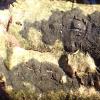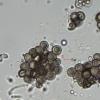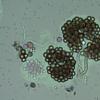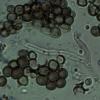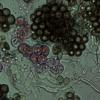
04-11-2025 09:07
Hello.A suspected Hymenoscyphus sprouting on a thi

04-11-2025 12:43
 Edvin Johannesen
Edvin Johannesen
Hi! One more found on old Populus tremula log in O

03-11-2025 21:34
 Edvin Johannesen
Edvin Johannesen
These tiny (0.4-0.5 mm diam.), whitish, short-stip

28-10-2025 15:37
Carl FarmerI'd be grateful for any suggestions for this strik

03-11-2025 16:30
 Hans-Otto Baral
Hans-Otto Baral
Hello I want to ask you if you have found this ye

28-10-2025 19:33
 Nicolas Suberbielle
Nicolas Suberbielle
Bonjour à tous,Je voudrais votre avis sur cette r

Good evening everybody,
A few days ago I found a Hypho on a living branch of Corylus avellana.
It had a rough darkgray surface without ostioles. Under the microscope I only found round spores of about 5µ , each with a large drop.I have no idea of the genus.Anyone can help?
Marc


I think that Periconia conidia do not have that thick wall.
We are not even sure that we have to do with an ascomycete. Could be aleuriospores, or even oospores of some oomycete.
We need a description and photos of the conidiophores or sporangiophores before we can make a further move.
Bernard

Dear Zotto and Bernard,
Thank you very much for your quick response.
I found some new microscopic features. Hyphal structures-conidiophores were scarse. They were all septated and thick-walled , size about 2µ, branched and bifurcated. Hyphae and spores were not echinulate. I did not find conidia in short chains as described in Periconia cambrensis. No match with other Periconia's in Dematiaceous Hypho's(MB Ellis)

To me there seems to be two conflicting concepts of Cheirospora botryospora:
1 - The anamorph of P.atrovinosa
2 - The anamorph of a species close to Mollisia, described here:
https://www.researchgate.net/publication/289618166_Fungal_systematics_and_Evolution_FUSE_1
I don't yet know which one is correct in the sense of the original, but at least they both seem separable morphologically (The former has darker, spherical conidia in loose clusters and the latter lighter, +/- oblong conidia in digitate chains).
This collection on Corylus clearly belongs to the former concept.....
Cheers,
Nick

The pictures of Cheirospora from Gernot Friebes in the base de données and the illustrations in The genera of Hyphomycetes match completely with my last photo.
Thank you very match for your help

